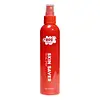What's inside
What's inside
 Key Ingredients
Key Ingredients

 Benefits
Benefits

 Ingredients Side-by-side
Ingredients Side-by-side

Water
Skin ConditioningSea Water
HumectantCentella Asiatica Extract
CleansingButylene Glycol
HumectantGlycerin
Humectant1,2-Hexanediol
Skin ConditioningGentiana Scabra Root Extract
Skin ConditioningPropanediol
SolventSodium Citrate
BufferingXanthan Gum
EmulsifyingEctoin
Skin ConditioningCeramide NP
Skin ConditioningSebacic Acid
Buffering10-Hydroxydecanoic Acid
Skin ConditioningPanthenol
Skin ConditioningCeramide EOP
Skin ConditioningCeramide AP
Skin ConditioningEthylhexylglycerin
Skin ConditioningViola Yedoensis Extract
Skin ConditioningGlyceryl Caprylate
EmollientCeramide As
Skin ConditioningCeramide Ns
Skin ConditioningCeramide Ng
Skin ConditioningHydroxyacetophenone
AntioxidantTaraxacum Officinale Rhizome/Root Extract
Skin ConditioningChamomilla Recutita Flower Extract
MaskingCrocus Sativus Flower Extract
MaskingPaeonia Lactiflora Root Extract
Skin ConditioningLonicera Japonica Flower Extract
Skin Conditioning1,10-Decanediol
SolventMalva Sylvestris Flower Extract
Skin ConditioningChrysanthemum Indicum Flower Extract
Skin ConditioningTaraxacum Mongolicum Extract
AntioxidantWater, Sea Water, Centella Asiatica Extract, Butylene Glycol, Glycerin, 1,2-Hexanediol, Gentiana Scabra Root Extract, Propanediol, Sodium Citrate, Xanthan Gum, Ectoin, Ceramide NP, Sebacic Acid, 10-Hydroxydecanoic Acid, Panthenol, Ceramide EOP, Ceramide AP, Ethylhexylglycerin, Viola Yedoensis Extract, Glyceryl Caprylate, Ceramide As, Ceramide Ns, Ceramide Ng, Hydroxyacetophenone, Taraxacum Officinale Rhizome/Root Extract, Chamomilla Recutita Flower Extract, Crocus Sativus Flower Extract, Paeonia Lactiflora Root Extract, Lonicera Japonica Flower Extract, 1,10-Decanediol, Malva Sylvestris Flower Extract, Chrysanthemum Indicum Flower Extract, Taraxacum Mongolicum Extract
Water
Skin ConditioningPropanediol
Solvent1,2-Hexanediol
Skin ConditioningHydroxyacetophenone
AntioxidantEctoin
Skin ConditioningPanthenol
Skin ConditioningLactobacillus Ferment
Skin ConditioningButylene Glycol
HumectantPentylene Glycol
Skin ConditioningSodium Dextran Sulfate
Gel FormingAlpha-Glucan Oligosaccharide
CleansingFructooligosaccharides
HumectantHydroxyphenyl Propamidobenzoic Acid
Skin ConditioningTaraxacum Officinale Leaf Extract
Skin ConditioningSaururus Chinensis Leaf/Root Extract
AntimicrobialXanthan Gum
EmulsifyingLactobacillus
Skin ConditioningStephania Tetrandra Root Extract
Skin ConditioningWater, Propanediol, 1,2-Hexanediol, Hydroxyacetophenone, Ectoin, Panthenol, Lactobacillus Ferment, Butylene Glycol, Pentylene Glycol, Sodium Dextran Sulfate, Alpha-Glucan Oligosaccharide, Fructooligosaccharides, Hydroxyphenyl Propamidobenzoic Acid, Taraxacum Officinale Leaf Extract, Saururus Chinensis Leaf/Root Extract, Xanthan Gum, Lactobacillus, Stephania Tetrandra Root Extract
 Reviews
Reviews

Ingredients Explained
These ingredients are found in both products.
Ingredients higher up in an ingredient list are typically present in a larger amount.
1,2-Hexanediol is a synthetic liquid and another multi-functional powerhouse.
It is a:
- Humectant, drawing moisture into the skin
- Emollient, helping to soften skin
- Solvent, dispersing and stabilizing formulas
- Preservative booster, enhancing the antimicrobial activity of other preservatives
Butylene Glycol (or BG) is used within cosmetic products for a few different reasons:
Overall, Butylene Glycol is a safe and well-rounded ingredient that works well with other ingredients.
Though this ingredient works well with most skin types, some people with sensitive skin may experience a reaction such as allergic rashes, closed comedones, or itchiness.
Learn more about Butylene GlycolEctoin is a compound found naturally in some species of bacteria. It can be synthetically created for skincare use.
This ingredient is an osmolyte; Osmolytes help organisms survive osmotic shock (it protects them from extreme conditions). It does this by influencing the properties of biological fluids within cells.
When applied to the skin, ectoin helps bind water molecules to protect our skin. The water forms a sort of armor for the parts of our skin cells, enzymes, proteins, and more.
Besides this, ectoin has many uses in skincare:
A study from 2004 found ectoin to counteract the damage from UV-A exposure at different cell levels. It has also been shown to protect skin against both UV-A, UV-B rays, infrared light, and visible light.
Studies show ectoin to have dual-action pollution protection: first, it protects our skin from further pollution damage. Second, it helps repair damage from pollution.
In fact, ectoin has been shown to help with:
Fun fact: In the EU, ectoin is used in inhalation medication as an anti-pollution ingredient.
Ectoin is a highly stable ingredient. It has a wide pH range of 1-9. Light, oxygen, and temperature do not affect this ingredient.
Learn more about EctoinHydroxyacetophenone is antioxidant with skin conditioning and soothing properties. It also boosts the efficiency of preservatives.
This ingredient is not irritating or sensitizing.
Panthenol is a common ingredient that helps hydrate and soothe the skin. It is found naturally in our skin and hair.
There are two forms of panthenol: D and L.
D-panthenol is also known as dexpanthenol. Most cosmetics use dexpanthenol or a mixture of D and L-panthenol.
Panthenol is famous due to its ability to go deeper into the skin's layers. Using this ingredient has numerous pros (and no cons):
Like hyaluronic acid, panthenol is a humectant. Humectants are able to bind and hold large amounts of water to keep skin hydrated.
This ingredient works well for wound healing. It works by increasing tissue in the wound and helps close open wounds.
Once oxidized, panthenol converts to pantothenic acid. Panthothenic acid is found in all living cells.
This ingredient is also referred to as pro-vitamin B5.
Learn more about PanthenolPropanediol is an all-star ingredient. It softens, hydrates, and smooths the skin.
It’s often used to:
Propanediol is not likely to cause sensitivity and considered safe to use. It is derived from corn or petroleum with a clear color and no scent.
Learn more about PropanediolWater. It's the most common cosmetic ingredient of all. You'll usually see it at the top of ingredient lists, meaning that it makes up the largest part of the product.
So why is it so popular? Water most often acts as a solvent - this means that it helps dissolve other ingredients into the formulation.
You'll also recognize water as that liquid we all need to stay alive. If you see this, drink a glass of water. Stay hydrated!
Learn more about WaterXanthan gum is used as a stabilizer and thickener within cosmetic products. It helps give products a sticky, thick feeling - preventing them from being too runny.
On the technical side of things, xanthan gum is a polysaccharide - a combination consisting of multiple sugar molecules bonded together.
Xanthan gum is a pretty common and great ingredient. It is a natural, non-toxic, non-irritating ingredient that is also commonly used in food products.
Learn more about Xanthan Gum